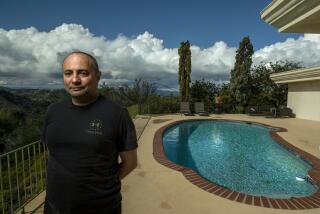Armenia’s tragedy was long in coming to the movie screen
- Share via
As producer Robert Lantos rose to introduce his friend, director Atom Egoyan, inspiration struck. Lantos was fresh from a trip to his native Hungary, where he had filmed the story of his family -- actually the story of Hungarian Jews from the turn of the century through communist rule -- in the epic movie “Sunshine.”
As he spoke at a function at the Armenian Community Center in Toronto, Lantos turned to Egoyan and said, “If and when the day comes when you are ready to tell the story of your people, as your friend and producer, I will stand by you.”
“It occurred to me that day that there was an important, almost magical moment or a parallel with Atom,” Lantos said, and that afternoon three years ago nudged Egoyan into writing about his Armenian heritage. The resulting movie, “Ararat,” opened Friday to favorable reviews and grossed an estimated $162,000 in five theaters.
Although many ethnic and racial groups in America have told their story -- Jews, African Americans, Asian Americans, Latinos, Italians, Irish and Greeks -- Armenians have never seen their story dramatized on the big screen. Egoyan’s “Ararat” is the first theatrically released feature film about the Armenians and the genocide. Historians estimate that 1.5 million Armenians from eastern Turkey perished from 1915 to 1923. Denying the genocide took place, the Turkish government maintains that the violence was precipitated by the outbreak of World War I.
Egoyan said he struggled to find a way to tell such a sweeping story.
“A lot of people have a hard time generally depicting history. Why do we need to witness atrocity?” he said. “How do you make people want to see that? The way you do that is to make it contemporary and to show that this can actually affect our contemporary lives.”
“Ararat” has prompted many Armenian Americans in Hollywood to ask themselves why it took so long to tell this story. Sylvia Minassian, founder of the Arpa Film Festival, an Armenian and international festival held annually in Los Angeles, estimates there are several hundred Armenian Americans working in Hollywood.
Heavyweights in the community include MGM owner Kirk Kerkorian, Oscar-winning screenwriter Steven Zaillian (“Schindler’s List”), producer Arthur Sarkissian (“Rush Hour”), manager Aleen Keshishian and her brother Alek, who directed Madonna’s “Truth or Dare” concert tour documentary.
Since 1935, attempts at making a film about the genocide have been either quashed by appeals from the Turkish government or turned down by studios leery of the controversy and unwilling to risk money on a historical epic.
Currently, the rights to Franz Werfel’s novel about the genocide, “The 40 Days of Musa Dagh,” are owned by German producer and director Ottokar Runze, but the script has been floating around for 10 years and is still in development. Mexican director Salvador Carrasco (“The Other Conquest”) hopes to direct another Armenian story, “Vergeen,” about a young girl who survives the genocide and comes to America to begin a new life.
Producer Howard Kazanjian (“Star Wars: Episode VI -- Return of the Jedi”) said he has tried half a dozen times over the last 30 years to get a studio on board, to no avail.
“We have not been able to raise the financing,” said Kazanjian, noting that even Steven Spielberg had a hard time raising the money to make “Schindler’s List.” “People are moving on -- they are looking for the next ‘Spider-Man.’ ”
The Armenian community itself has not been responsive to his attempts to raise money, Kazanjian said.
“As generous as Armenians are in giving to the church and philanthropic organizations, I have not been able to get them to put up one dime to make this movie,” he said. “They want it, but they don’t want to support it. Their fathers and mothers and relatives were killed -- they want it, but they don’t want to see it.”
Alex Yemenidjian, who is Armenian and the chief executive of MGM, passed on “Ararat” when Egoyan brought him the script.
“I liked the script, but economically it did not make much sense,” Yemenidjian said. “You have to look at the above-the-line costs, below-the-line costs.... While your heart says one thing and your mind says another, I have a fiduciary responsibility to my shareholders.”
It was Miramax Films founder Harvey Weinstein who decided to distribute the film in the U.S. Lantos’ Serendipity Point Films and Telefilm Canada produced the $11-million movie with Miramax pitching in.
Weinstein said he had never really heard of the Armenian genocide until Egoyan brought him the script. Once he read it and did his own research, he felt it was time to tell the story. Having lost eight relatives at Auschwitz, Weinstein related well to the subject, although he said he expects to lose money on the film.
“I thought it was way too compelling to ignore,” said Weinstein, who doesn’t mind losing money on a film as long as Miramax continues to make it up on others. “Financially it doesn’t make sense, but so what? It makes common sense, which is more important.”
Zaillian said he has wanted to write a story about the Armenian American experience but, as a third-generation Californian, felt somewhat disconnected from his grandparents’ homeland. Like many Armenian Americans who are fully assimilated into American culture, he said he had relatively little contact with other Armenians when he was growing up in a Los Angeles suburb in the 1950s.
“Experience isn’t always necessary, of course -- research can sometimes make up for it -- but in this case, the lack of it has ... produced a lack of confidence in myself to do it well,” Zaillian said. He said he was excited and even a little jealous when Egoyan sent him the “Ararat” script to read. “So much time had gone by without anyone having done it, I’d let myself get complacent, thinking, ‘One of these days I’ll get to it.’ ”
More to Read
Only good movies
Get the Indie Focus newsletter, Mark Olsen's weekly guide to the world of cinema.
You may occasionally receive promotional content from the Los Angeles Times.










